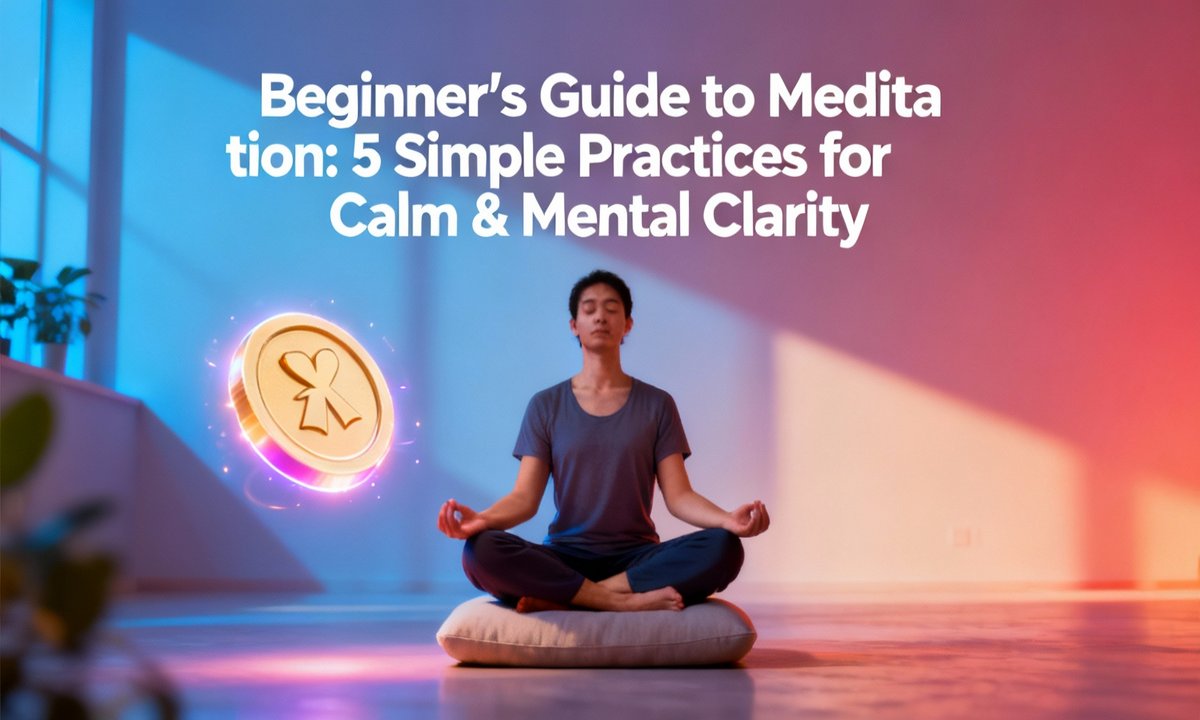Meditation for beginners isn’t about striving for perfection—it’s simply about showing up with a willingness to try. You don’t need special equipment or hours of free time to begin this journey. When you carve out time to practice meditation, you are gifting yourself a moment of calm, improved mental clarity, and a deeper sense of presence. Even just a few minutes daily can make a noticeable difference in your life.
Understanding the Basics of Beginner Meditation
Why Start Meditating Now?
Meditation offers powerful, science-backed benefits that support modern well-being. Consistent practice naturally reduces stress, eases anxiety, and helps sharpen your focus on important tasks. Studies show that this simple habit can also help you sleep better, strengthen emotional resilience, and boost your overall quality of life. Beginners often discover a surprising sense of immediate calm, even amid chaotic days ([Headspace](https://www.headspace.com/meditation/meditation-for-beginners)). Starting is the most essential step; you don’t need to perfectly clear your mind to gain the benefits.
What Exactly Is Meditation? A Gentle Introduction
Meditation is fundamentally the practice of bringing your attention fully into the present moment. This might involve focusing intently on your breath, tuning into subtle body sensations, or gently guiding your mind with peaceful imagery. There is no single correct method: every small effort counts, and every moment you return your focus is a step toward mental growth ([Mindful.org](https://www.mindful.org/how-to-meditate/)).
Core Benefits for Everyone:
Reduces stress and calms anxiety.
Builds mental clarity and sharpens focus.
Supports emotional resilience and well-being.
Cultivates a sense of calm you can access anytime, anywhere.
Clearing Up Common Meditation Myths
Starting Your Practice With Ease
It is a common misconception that you need abundant time, absolute silence, or a perfectly blank mind to succeed at meditation. In reality, this practice is accessible to everyone, even if your life feels inherently busy or noisy. It is perfectly normal for your mind to wander; in fact, the practice is simply noticing the drift and gently bringing your attention back, without self-judgment.
Start with just one minute—even small, consistent steps quickly lead to noticeable benefits. If stressors at home make it hard to find peace, remember that a cozy, decluttered space can significantly support your routine. For inspiring ideas on creating a calm environment, you may explore guides focused on deep cleaning and organizing ([Seasonal Refresh: Your Ultimate Guide to Deep Cleaning & Organizing](https://arowanakorea.com/seasonal-refresh-deep-cleaning-organizing-guide)).
Five Simple Meditation Practices to Cultivate Calm and Clarity
1. Breath Awareness Meditation
Sit or lie down in a position that feels comfortable. You can gently close your eyes or simply lower your gaze toward the floor. Notice the feeling of your natural breath—feel the cool air on the inhale and the warmth on the exhale.
If your mind drifts away, softly guide your attention back to the sensation of breathing. Start with 2–3 minutes and gradually add time as you wish. This technique grounds your attention, helps quiet anxious thoughts, and effectively sharpens focus ([Headspace](https://www.headspace.com/meditation/meditation-for-beginners)).
2. Body Scan Meditation
Bring your awareness slowly through your body, moving from the top of your head to the tips of your toes. Pause intentionally at each body part, noticing any sensations you find—warmth, tension, or relaxation—without attempting to change them. A body scan is known to reduce physical tension and reconnect your mind and body.
This practice encourages deep, restful relaxation and is especially helpful at bedtime, following exercise, or whenever you need a quick mental and physical reset ([Mindful.org](https://www.mindful.org/how-to-meditate/)).
3. Guided Visualization
Find a comfortable and peaceful place to settle in. You can listen to a pre-recorded guided meditation or simply imagine calming scenes in your mind: a quiet park, sunlit forest paths, or gentle ocean waves. Allow these peaceful images to gently soothe your mind.
Visualization encourages a more positive mood, effectively eases mental overload, and makes mindfulness feel immediately accessible to every beginner.
4. Mindfulness of Breathing
In this practice, you observe each breath exactly as it is, without trying to alter its rhythm or depth. Pay gentle attention to the physical location where you feel the breath most strongly—is it in your chest, your belly, or near your nose?
When thoughts inevitably wander, gently and kindly bring your focus back to the chosen point of attention. This form of meditation is excellent for boosting your attention span and cultivating acceptance and calm resilience.
5. 1-Minute On-the-Go Meditation
This micro-practice is perfect for busy days. Wherever you find yourself—in the car, waiting in line, or at your desk—pause for a single minute. Focus intentionally on three slow, deep breaths. Then, gently tune into the immediate sensations and sounds around you. This short technique provides immediate stress relief and is an accessible meditation tip for integrating peace into busy schedules ([Mindful.org](https://www.mindful.org/how-to-mediate/)).
Building a Consistent Meditation Habit
Making It Stick: Simple Steps for Beginners
Consistency is more valuable than duration when starting out. Even just 1–5 minutes daily is enough to begin noticing real changes. To support this new habit, try to link your meditation time to an existing daily routine, such as after your morning coffee or right before you go to bed.
Consider creating a dedicated space. A quiet nook or cozy corner can help reinforce the routine, but the true flexibility of meditation means you can practice anywhere. For inspiration on simplifying your home to support well-being, explore smart gadgets that can help simplify your life ([The Minimalist Home: Essential Gadgets That Actually Simplify Your Life](https://arowanakorea.com/simplify-home-smart-gadgets)).
Tips for Maintaining Momentum
Start Small and Build Gradually
Aim for small, realistic goals, such as “I will meditate for three minutes before breakfast.” Lay out a cushion or chair the night before to encourage follow-through and make starting easier.
Use Accessible Support Tools
Apps and free online audio offer guided meditation specifically tailored for beginners, which often include helpful reminders and progress tracking. This can support various learning styles and keep you consistently motivated.
Cultivate a Gentle Attitude
Your mind will wander frequently—this is not a failure, but simply part of being human. The practice is returning your focus to your breath or point of attention without judgment. There is no need for perfection in this journey.
Stay Consistent
Remember that consistent, daily meditation, even when kept very brief, yields the best and most lasting results. Some days will feel easier than others, so just return to the practice when you can, without self-criticism or guilt.
Addressing Common Beginner Concerns
Frequently Asked Questions About Mindfulness
How many minutes should I meditate?
For those just starting out, even a single minute each day brings powerful benefits. Try beginning with 2–5 minutes and gradually increase the duration as you feel more comfortable. Consistency is often more effective than attempting long sessions, so show up regularly and you will notice progress.
Can meditation help manage anxiety?
Yes, absolutely. Extensive evidence suggests that consistent mindfulness exercises and meditation practices effectively reduce anxiety levels and substantially increase overall emotional resilience over time. Many beginners report feeling significantly calmer after engaging in just a few sessions.
What if my mind keeps wandering during the session?
This is a universal experience that happens to everyone, regardless of their experience level. When you notice your thoughts drifting, simply and kindly bring your attention back to your breath or chosen focus. Every return is a successful moment—this is precisely how you build mental clarity and self-acceptance.
Is it possible to meditate if my environment is noisy?
Certainly. You can practice meditation even with background noise—the goal is to allow those sounds to become a natural part of your general awareness, accepting them without judgment. If possible, helpful tools like noise-canceling headphones or soft ambient music can often help support your initial focus.
Your Meditation Journey Begins Now
Taking the Next Step Toward Calm
Are you ready to give this practice a try? Choose just one of the simple beginner meditation practices outlined above and consciously carve out a quiet moment today. Set a gentle reminder for tomorrow, as consistency is truly where meaningful, lasting change takes place.
If you are currently working on creating a tranquil home space or minimizing daily stressors to support your wellness routine, exploring related guides can be helpful. Simplifying your physical space with practical advice can often help clear the mental space you need for mindfulness.
Meditation is available and accessible to you—no matter your background, beliefs, or current level of busyness. Each intentional breath of awareness helps build resilience. Every gentle return to focus brings you greater clarity and inner peace. Start today, and be sure to celebrate every small step of your journey.
Ready to begin? Download a free meditation tracker and subscribe for more mindfulness tips!
Image credits: Peaceful corners, mindfulness apps, and gentle diagrams are suggested for a visually engaging, restful reading experience.



